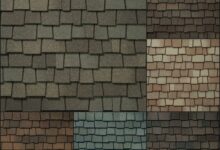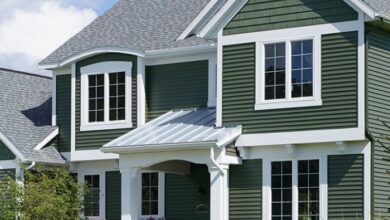James Hardie Stucco Panel A Complete Guide
James Hardie stucco panels offer a compelling alternative to traditional stucco, boasting superior durability and a range of aesthetic options. This comprehensive guide delves into every aspect of these panels, from their manufacturing process and installation to their long-term maintenance and environmental impact. We’ll explore the various types available, compare them to other siding choices, and provide practical tips for budgeting and installation to ensure your project is a success. Get ready to transform your home’s exterior with the enduring beauty and performance of James Hardie.
Whether you’re a homeowner planning a renovation or a contractor seeking a high-quality exterior cladding solution, understanding the nuances of James Hardie stucco panels is crucial. This guide provides a detailed breakdown of the product’s features, benefits, and potential drawbacks, equipping you with the knowledge to make informed decisions throughout the process. We’ll cover everything from selecting the right panels for your project to managing the installation and maintenance effectively.
Product Overview: James Hardie Stucco Panel
James Hardie stucco panels offer a durable and attractive alternative to traditional stucco, combining the aesthetic appeal of stucco with the enhanced performance characteristics of fiber cement. This innovative siding solution provides homeowners with a low-maintenance, long-lasting exterior that can withstand the harshest weather conditions. Understanding the manufacturing process, available options, and comparative advantages is key to appreciating its value proposition.
James Hardie Stucco Panel Manufacturing
James Hardie stucco panels are engineered using a proprietary process that blends cellulose fibers, cement, and other additives. The mixture is then formed into panels under high pressure, ensuring a dense and consistent product. These panels are cured in a controlled environment to achieve optimal strength and durability. A final step involves applying a protective coating, enhancing weather resistance and providing a smooth, paintable surface. This rigorous manufacturing process results in a product that’s resistant to cracking, shrinking, and warping, common problems associated with traditional stucco.
James Hardie Stucco Panel Types and Sizes
The James Hardie stucco panel range offers a variety of options to suit different architectural styles and project needs. Sizes typically vary, with standard panel dimensions offering flexibility for installation on various building types and sizes. While specific dimensions and product lines may vary by region and availability, common features include variations in texture and color, allowing for customization to match personal preferences and the overall aesthetic of a home. Contacting a local James Hardie dealer is recommended to determine the precise options available in your area.
James Hardie Stucco Panels vs. Traditional Stucco: A Feature Comparison
Traditional stucco, while visually appealing, is susceptible to cracking, moisture damage, and requires significant maintenance. James Hardie stucco panels offer several key advantages:
| Feature | James Hardie Stucco Panels | Traditional Stucco |
|---|---|---|
| Durability | Highly durable, resistant to cracking, warping, and insect damage | Prone to cracking, shrinking, and damage from moisture |
| Maintenance | Low maintenance; requires less frequent repainting | High maintenance; requires regular repairs and repainting |
| Water Resistance | Excellent water resistance; helps prevent moisture intrusion | Susceptible to water damage if not properly applied and maintained |
| Installation | Generally faster and easier installation | More labor-intensive and time-consuming installation process |
Cost-Effectiveness of James Hardie Stucco Panels
While the initial cost of James Hardie stucco panels may be higher than some other siding options, the long-term cost-effectiveness is a significant factor. The reduced maintenance requirements and increased longevity translate to lower overall lifetime costs.
| Siding Material | Initial Cost (per sq ft – estimate) | Maintenance Cost (per year – estimate) | Longevity (years) |
|---|---|---|---|
| James Hardie Stucco Panels | $8-$15 | $0-$2 | 50+ |
| Vinyl Siding | $3-$7 | $0-$1 | 20-30 |
| Traditional Stucco | $5-$12 | $5-$10 | 20-30 |
| Wood Siding | $6-$15 | $3-$8 | 15-25 |
Note: These cost estimates are approximate and can vary significantly based on location, labor costs, and specific product choices. Consult with local contractors for accurate pricing in your area.
Installation and Application
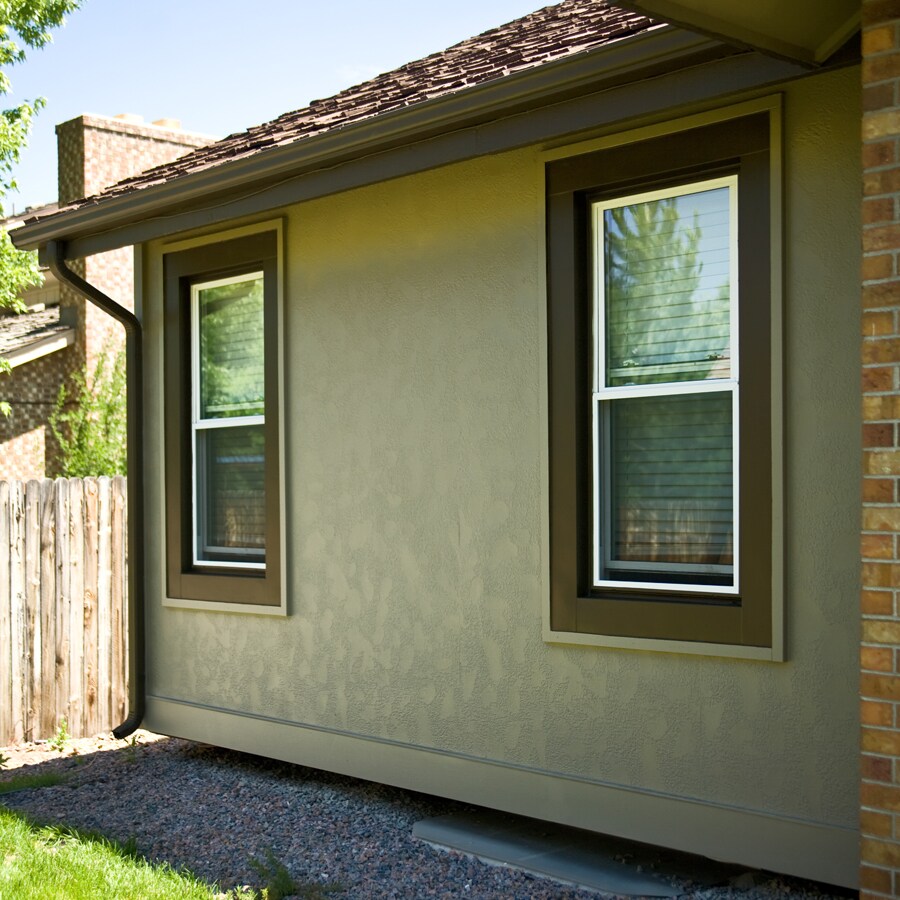
Installing James Hardie stucco panels is a straightforward process, but proper preparation and technique are crucial for a long-lasting, aesthetically pleasing finish. This section details the steps involved, necessary tools and materials, potential challenges, and solutions. Understanding these aspects ensures a successful installation, minimizing issues and maximizing the lifespan of your siding.
Tools and Materials
A successful James Hardie stucco panel installation requires the right tools and materials. Having everything prepared beforehand streamlines the process and prevents costly delays. Insufficient materials or improper tools can lead to installation errors and compromise the final result.
- Measuring Tape: Accurate measurements are fundamental for precise cutting and panel placement.
- Circular Saw with a fine-tooth blade: Essential for accurate cutting of the panels to size.
- Safety Glasses and Gloves: Protecting yourself from potential hazards is paramount.
- Level: Ensuring panels are installed plumb and level prevents unsightly irregularities.
- Hammer and Nail Gun (with appropriate nails): Securely fastening the panels is critical for structural integrity.
- Caulk Gun and Caulk: Sealing gaps and joints prevents water intrusion and improves the overall aesthetic.
- J-Channel and Corner Trim: These provide a neat finish at edges and corners.
- James Hardie Stucco Panels: Ensure you order enough panels to cover the entire area, accounting for waste.
- Flashing: Proper flashing is essential for preventing water damage behind the panels, particularly around windows and doors.
- Underlayment (if required): Depending on the application, underlayment might be necessary to create a smooth surface.
Step-by-Step Installation Guide
The installation process should be approached systematically to ensure a quality finish. Each step plays a crucial role in the overall success of the project. Following these steps will minimize potential problems and maximize the longevity of the installation.
- Preparation: Begin by carefully measuring the area to be covered. This allows for accurate panel ordering and cutting. Ensure the wall surface is clean, dry, and free of any loose debris.
- Framing (if necessary): If installing over existing sheathing, ensure it’s sound and properly prepared. New framing may be required depending on the project.
- Installation of J-Channel and Corner Trim: Install J-Channel around windows, doors, and corners to create a neat and watertight seal. Corner trim provides a professional finish at external corners.
- Panel Installation: Start at a corner and work your way across, ensuring each panel is level and plumb. Use the appropriate nails and fasten securely according to manufacturer’s instructions.
- Caulking: After installing all panels, carefully caulk all joints and seams to prevent water penetration. Pay close attention to areas around windows, doors, and corners.
- Finishing: Once the caulk has dried, inspect the installation for any imperfections and address them accordingly.
Common Installation Challenges and Solutions
Certain challenges can arise during James Hardie stucco panel installation. Knowing these potential issues beforehand allows for proactive solutions and prevents costly mistakes. Addressing these problems efficiently maintains project timelines and ensures a quality result.
- Uneven Wall Surfaces: Uneven walls can lead to difficulty in installing panels flush. Solution: Use shims to level the panels and ensure a smooth surface.
- Improper Cutting: Incorrectly cut panels can lead to gaps and poor aesthetics. Solution: Use a sharp, fine-tooth blade and a straight edge for accurate cuts.
- Nail Placement: Incorrect nail placement can cause damage to the panels or compromise structural integrity. Solution: Follow the manufacturer’s recommendations for nail spacing and placement.
- Water Intrusion: Poor sealing around joints and seams can lead to water damage. Solution: Use high-quality caulk and ensure all seams are properly sealed.
Visual Representation of Installation
Imagine a house with existing siding removed. The underlying sheathing is inspected and prepared. J-Channel is installed neatly around window and door frames. The first panel is placed at a corner, leveled using a level, and secured with nails. Subsequent panels are installed, overlapping slightly, and ensuring consistent spacing. Caulk is applied to all joints, creating a seamless and watertight seal. Finally, corner trim is installed to complete the professional look. The overall appearance should be clean, uniform, and consistent with the manufacturer’s specifications. The finished product exhibits a smooth, even surface free of gaps or imperfections.
Maintenance and Durability
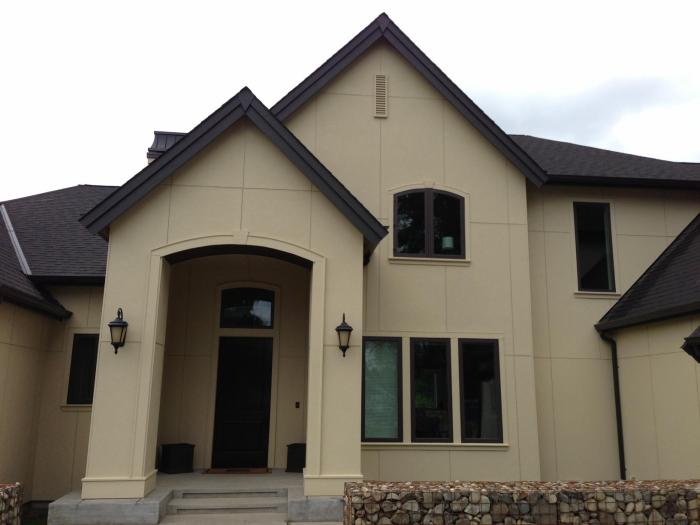
James Hardie stucco panels are engineered for longevity and low-maintenance performance, but understanding proper care and realistic expectations regarding lifespan is crucial for maximizing their investment value. This section details maintenance tips, expected lifespan under various conditions, warranty information, and a comparison to other exterior cladding options.
Proper maintenance of your James Hardie stucco panels significantly extends their lifespan and preserves their aesthetic appeal. Regular cleaning removes dirt, grime, and potential contaminants that could damage the surface over time. This preventative approach minimizes the need for costly repairs down the line, ensuring a long-lasting, attractive exterior for your home.
Cleaning and Maintenance Procedures
Cleaning James Hardie stucco panels is straightforward. A simple solution of mild detergent and water, applied with a soft brush or sponge, is usually sufficient to remove dirt and debris. For tougher stains, a pressure washer can be effective, but it’s essential to maintain a safe distance (at least 12 inches) to avoid damaging the surface. Always rinse thoroughly with clean water afterward. Avoid abrasive cleaners or harsh chemicals, as these can damage the finish. Regular inspection for any signs of damage, such as cracks or loose panels, is also recommended. Prompt attention to minor issues prevents them from escalating into larger, more expensive problems.
Expected Lifespan and Durability
James Hardie stucco panels are designed to withstand a wide range of weather conditions. Their fiber cement composition makes them resistant to rot, insect infestation, and fire. In typical climates, with routine maintenance, a lifespan of 30 years or more is common. However, exposure to extreme weather, such as prolonged periods of intense sun, freezing temperatures, or severe storms, can affect the lifespan. Coastal areas, with their salty air and high humidity, may require more frequent maintenance. For example, a home in a desert climate might experience accelerated fading due to intense UV exposure, whereas a home in a consistently humid environment might show more susceptibility to moisture-related issues if not properly maintained. These factors can influence the rate of weathering and necessitate more frequent cleaning or occasional repairs.
Warranty Information
James Hardie offers a comprehensive warranty for its stucco panels, which typically covers manufacturing defects. The specific terms and conditions of the warranty vary depending on the product and region. It is crucial to consult the warranty document provided with the product or contact James Hardie directly for detailed information. The warranty generally doesn’t cover damage resulting from improper installation, neglect, or acts of God. Understanding the warranty limitations is essential to avoid any misunderstandings or disputes regarding potential repairs or replacements.
Maintenance Compared to Other Cladding Materials
Compared to other exterior cladding materials, James Hardie stucco panels require relatively low maintenance. Unlike wood, they are not susceptible to rot or insect damage, eliminating the need for regular treatments or repairs associated with wood decay. They require less upkeep than vinyl siding, which can crack or fade over time. While some materials, like brick or stone, may offer greater longevity, they often require more extensive and potentially costly repairs if damaged. The combination of durability and manageable maintenance requirements positions James Hardie stucco panels as a cost-effective and long-lasting exterior cladding solution.
Design and Aesthetics
James Hardie stucco panels offer a compelling blend of durability and aesthetic versatility, significantly enhancing a home’s curb appeal and architectural character. Their ability to mimic the look of traditional stucco without the inherent maintenance challenges makes them a popular choice for homeowners seeking both beauty and longevity. The range of colors and textures available allows for seamless integration with various architectural styles and personal preferences.
James Hardie stucco panels elevate a home’s exterior by providing a clean, sophisticated finish. The panels’ smooth surfaces create a modern and sleek look, while textured options can add depth and visual interest, evoking a sense of warmth and traditional charm. This versatility allows for customization to match any homeowner’s vision, transforming the exterior from ordinary to extraordinary.
Architectural Style Integration
James Hardie stucco panels adapt seamlessly to a wide array of architectural styles. For instance, their smooth finishes complement contemporary designs, creating a minimalist and elegant façade. Conversely, textured options readily integrate with traditional styles like Craftsman or Victorian, adding richness and depth to the home’s exterior. The panels’ versatility allows for the creation of striking contrasts and harmonious blends, depending on the chosen texture and color. In Mediterranean-style homes, the panels can be used to create a stucco-like finish that evokes the sun-drenched landscapes of the region. Similarly, in Ranch-style homes, the panels can add a clean and modern update to a classic design.
Color and Texture Options
The following descriptions illustrate the diverse color and texture options available with James Hardie stucco panels:
Image 1: A panel showcasing a warm, earthy tone reminiscent of aged terracotta. The texture is subtly rough, mimicking the look of hand-applied stucco. This image demonstrates a rustic, Mediterranean feel.
Image 2: This image displays a smooth, cool-toned gray panel. The sleek, contemporary finish is perfect for modern architectural styles. The color is a consistent, even shade with no visible texture.
Image 3: A panel in a creamy off-white hue is depicted. This image highlights a subtly textured surface with a slightly pebbled appearance, providing a classic and timeless appeal.
Image 4: This image shows a deep, charcoal-gray panel with a pronounced, heavily textured surface. The rough texture adds significant visual depth and a rustic, almost industrial feel.
Material Integration
| James Hardie Stucco Panel | Complementary Material | Architectural Style Example | Aesthetic Result |
|---|---|---|---|
| Smooth, Gray Panel | Dark-framed windows, metal siding | Modern | Sleek, contemporary |
| Textured, Beige Panel | Stone accents, wood trim | Craftsman | Warm, inviting, traditional |
| Rough, Terracotta Panel | Clay tile roof, wrought iron accents | Mediterranean | Rustic, sun-drenched, charming |
| Smooth, White Panel | Dark-colored shutters, brick accents | Colonial | Classic, elegant, timeless |
Environmental Impact and Sustainability
James Hardie, a leading manufacturer of fiber cement siding, recognizes the importance of minimizing its environmental footprint. The company’s commitment to sustainability is woven into its manufacturing processes, product lifecycle, and broader corporate strategy. This section details the environmental impact of James Hardie stucco panels, the company’s sustainability initiatives, and a comparison to alternative siding materials.
Manufacturing Process Environmental Impact
The production of James Hardie stucco panels involves several stages, each with potential environmental implications. Cement production, a key component of the manufacturing process, contributes to greenhouse gas emissions, primarily carbon dioxide. However, James Hardie actively works to reduce this impact through various efficiency improvements in their manufacturing plants, including optimizing energy consumption and exploring alternative, lower-carbon cement formulations. The sourcing of raw materials, such as wood fibers, also carries environmental considerations, necessitating responsible forestry practices and sustainable sourcing strategies. Water usage in the manufacturing process is another area of focus, with the company implementing water conservation measures to minimize its impact on local water resources. Waste management is also crucial, and James Hardie strives to minimize waste generation and maximize recycling and reuse of byproducts.
James Hardie’s Sustainability Initiatives
James Hardie has implemented a range of sustainability initiatives across its operations. These include investing in renewable energy sources to power its manufacturing facilities, reducing energy consumption through operational efficiency improvements, and actively pursuing certifications that validate their commitment to environmental stewardship, such as LEED certification for their buildings. Furthermore, the company actively participates in various environmental programs and collaborates with industry partners and stakeholders to promote sustainable practices throughout the value chain. Their commitment extends to responsible sourcing of raw materials, ensuring that wood fibers are sourced from sustainably managed forests, thereby minimizing deforestation and promoting biodiversity. Transparency is also a key aspect of their sustainability strategy, with regular reporting on their environmental performance and progress towards their sustainability goals.
Environmental Footprint Comparison to Alternative Siding Options
Compared to traditional wood siding, James Hardie stucco panels offer several environmental advantages. Wood siding requires significant ongoing maintenance, often involving the use of environmentally harmful chemicals. Replacing damaged wood siding also contributes to waste generation. In contrast, James Hardie fiber cement siding boasts superior durability and longevity, reducing the need for frequent replacements and associated environmental impacts. Compared to vinyl siding, which is derived from petroleum and is not easily recyclable, James Hardie stucco panels offer a more sustainable alternative. While the initial embodied carbon footprint of James Hardie products may be higher than some other options, their longevity and reduced need for replacement over time significantly reduces the overall life-cycle environmental impact. A life-cycle assessment (LCA) would be needed to provide a definitive quantitative comparison.
Recyclability and Disposal Methods
While James Hardie stucco panels are not directly recyclable in the same way as some other materials, they are durable and long-lasting, significantly reducing the frequency of replacement and associated waste. At the end of their lifespan, the panels can be disposed of responsibly through appropriate waste management channels. Depending on local regulations and waste management infrastructure, this might involve landfill disposal or potentially, in some regions, incorporation into aggregate for construction purposes. James Hardie encourages responsible disposal practices and recommends contacting local waste management authorities for specific guidance on disposal methods in your area.
Cost Considerations and Budgeting
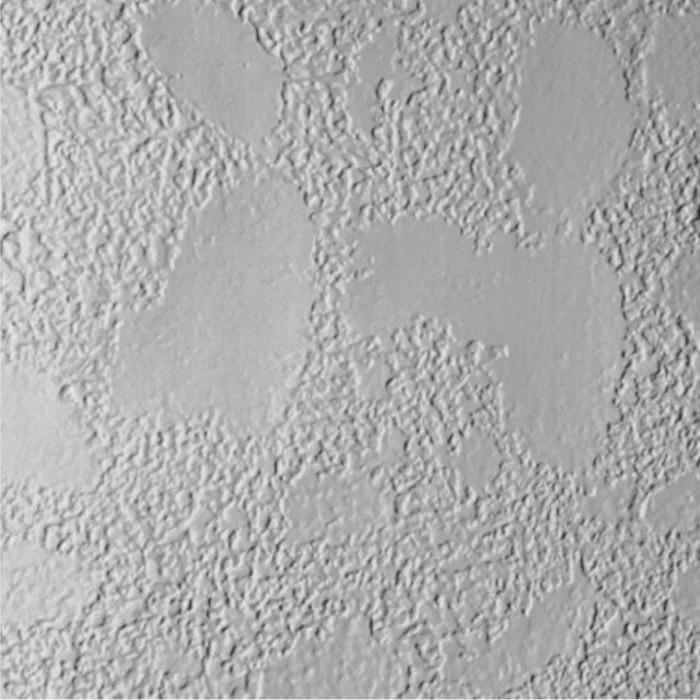
Planning a James Hardie stucco panel installation requires careful consideration of the associated costs. The total expense can vary significantly depending on several factors, making accurate budgeting crucial for a successful project. Understanding these cost components and implementing effective budgeting strategies can help you manage your investment effectively.
Material Costs, James hardie stucco panel
The cost of James Hardie stucco panels themselves is a major factor. Prices fluctuate based on the specific panel type, size, color, and texture chosen. Larger panels generally reduce installation time and labor costs, but the initial material expense might be higher. Premium colors and textures will also add to the overall material cost. For example, a standard 12′ x 4′ panel might cost between $30 and $70, while a larger, more textured panel could reach $100 or more. Regional variations in pricing also need to be considered, as transportation and distribution costs affect the final price at your local supplier. It’s advisable to obtain multiple quotes from different suppliers to compare prices and ensure you’re getting the best deal.
Labor Costs
Labor costs represent a significant portion of the total project expense. The hourly rate of professional installers varies widely based on geographic location, experience, and demand. The complexity of the project, including the size of the area to be covered, the number of corners and intricate details, and any required demolition or preparation work, directly impacts labor hours and thus the total labor cost. A simple installation on a small area might cost a few thousand dollars, while a large, complex project could easily reach tens of thousands. Securing multiple quotes from reputable installers is crucial to compare labor costs and ensure you are getting a fair price for the scope of work.
Installation-Related Costs
Beyond the direct cost of materials and labor, several other factors contribute to the overall expense. These include permits and inspections, which are mandatory in most jurisdictions and vary in cost depending on location and project complexity. Waste removal is another factor; proper disposal of construction debris is essential and adds to the overall cost. Finally, additional materials such as flashing, fasteners, and sealants are necessary for a complete and professional installation, further impacting the budget. Accurately estimating these secondary costs is crucial for a comprehensive budget.
Creating a Budget for James Hardie Stucco Panel Installation
Creating a realistic budget involves breaking down the project into its constituent parts and assigning cost estimates to each. Start by calculating the total square footage of the area to be covered. Then, research the cost of materials per square foot, factoring in the chosen panel type, color, and texture. Next, obtain quotes from several reputable installers to determine labor costs. Remember to factor in the costs of permits, waste removal, and additional materials. Add these figures together to arrive at a total project cost. Building in a contingency buffer of 10-15% is prudent to account for unforeseen expenses or cost overruns. For example, if your initial estimate is $10,000, adding a 15% contingency results in a total budget of $11,500.
Tips for Saving Money on James Hardie Stucco Panel Projects
Several strategies can help minimize the overall cost. Consider opting for standard colors and textures to reduce material costs. Planning the project carefully to minimize waste can also save money on materials. Comparing quotes from multiple installers and negotiating prices can significantly reduce labor expenses. Finally, explore the possibility of DIY installation for certain aspects of the project, if you have the necessary skills and experience, to reduce labor costs. However, it’s crucial to weigh the potential savings against the risk of improper installation and resulting damage or voiding warranties.
From initial design considerations to long-term maintenance, James Hardie stucco panels present a strong case for homeowners and builders seeking a durable, aesthetically pleasing, and relatively low-maintenance exterior solution. By carefully weighing the costs, understanding the installation process, and appreciating the long-term benefits, you can confidently incorporate these panels into your next project. Remember to factor in the specific needs of your climate and architectural style to ensure optimal performance and curb appeal. The investment in James Hardie stucco panels promises a significant return in the form of increased property value and lasting beauty.
Q&A: James Hardie Stucco Panel
What is the warranty on James Hardie stucco panels?
James Hardie offers a 30-year warranty on its stucco panels, protecting against manufacturing defects.
Can James Hardie stucco panels be painted?
Yes, James Hardie stucco panels can be painted using exterior-grade paints designed for fiber cement products. Proper surface preparation is essential for optimal adhesion and longevity.
Are James Hardie stucco panels fire-resistant?
Yes, they are non-combustible and offer a significant degree of fire protection compared to many other siding materials.
How do I clean James Hardie stucco panels?
Regular cleaning with a mild detergent and water is usually sufficient. For stubborn stains, a pressure washer can be used, but avoid excessive pressure to prevent damage.
What is the average lifespan of James Hardie stucco panels?
With proper maintenance, James Hardie stucco panels can last for 50 years or more.





